Herodotus › Bardr mac Imair › Ancient Greek Warfare » Origins and History
Articles and Definitions › Contents
- Herodotus › Who Was
- Bardr mac Imair › Who Was
- Ancient Greek Warfare › Origins
Ancient civilizations › Historical places, and their characters
Herodotus › Who Was
Definition and Origins
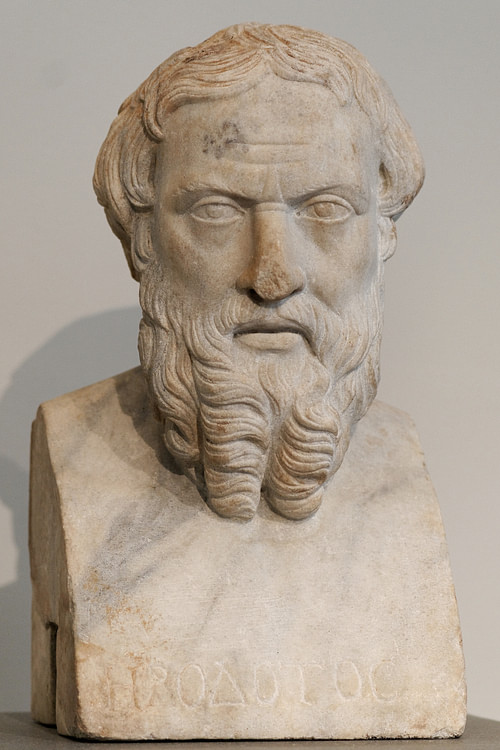
Herodotus (c. 484 – 425/413 BCE) was a Greek writer who invented the field of study known today as `history'. He was called `The Father of History' by the Roman writer and orator Cicero for his famous work The Histories but has also been called “The Father of Lies” by critics who claim these `histories' are little more than tall tales.
RELIABILITY
Criticism of Herodotus' work seems to have originated among Athenians who took exception to his account of the Battle of Marathon (490 BCE) and, specifically, which families were due the most honor for the victory over the Persians. More serious criticism of his work has to do with the credibility of the accounts of his travels.
One example of this is his claim of fox-sized ants in Persia who spread gold dust when digging their mounds. This account has been rejected for centuries until, in 1984 CE, the French author and explorer Michel Peissel, confirmed that a fox-sized marmot in the Himalayas did indeed spread gold dust when digging and that accounts showed the animal had done so in antiquity as the villagers had a long history of gathering this dust.
HERODOTUS MOVES FLUIDLY THROUGH HIS WORK FROM CULTURE TO CULTURE & IS ALWAYS MOST INTERESTED IN TELLING A GOOD STORY.
Peissel also explains that the Persian word for `mountain ant' was very close to their word for `marmot' and so it was established that Herodotus was not making up his giant ants but, since he did not speak Persian and had to rely on translators, was the victim of a misunderstanding in translation. This same scenario could apply to other observations and claims found in Herodotus' histories though, certainly, not all. In the interests of telling a good story, Herodotus sometimes indulged in speculation and, at other times, repeated stories he had heard as though they were his own experiences.
EARLY LIFE & TRAVELS
While little is known of the details of his life, it seems certain that he came from a wealthy, aristocratic family in Asia Minor who could afford to pay for his education. His skill in writing is thought to be evidence of a thorough course in the best schools of his day. He wrote in Ionian Greek and was clearly well read. His ability to travel, seemingly at will, also argues for a man of some means. It is thought he served in the army as a Hoplite in that his descriptions of battle are quite precise and always told from the point of view of a foot soldier.
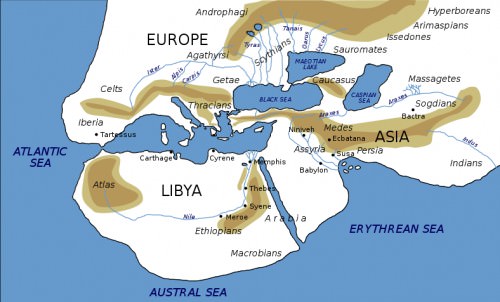
World Map of Herodotus
Scholar Robin Waterfield comments on Herodotus' early life:
Herodotus was not a native of Athens. He was born in Halicarnassus (the modern Turkish city of Bodrum), about the time of the Persian Wars. Halicarnassus was a Dorian town with substantial intermarriage among its Greek, Carian, and Persian populations...If the later ancient reports that have come down to us are correct, his family was exiled during the troubled years after the Persian Wars, and as a very young man Herodotus may have lived on the island of Samos. His occasional comments in the Histories show us that he travelled widely around the world of the east Mediterranean. We do not know when and how the Histories were first written down;very likely, however, they arose out of recitations or readings that he gave over a number of years in other Greek cities and in Athens at the height of its imperial power. (x)
HERODOTUS' PENCHANT FOR STORYTELLING, & HIS OBVIOUS TALENT FOR IT, HAVE ALARMED & ANNOYED CRITICS SINCE ANTIQUITY.
If Waterfield is correct, Herodotus' early experience with travel would have shaped his later inclinations; he does not seem to have stayed in any one place very long. He moves fluidly through his work from culture to culture and is always most interested in telling a good story and less so with fact-checking the details of the tales he heard and repeats in his pages. It is this tendency of his, as noted, which has given rise to the centuries of criticism against him.
THE HISTORIES
While it is undeniable that Herodotus makes some mistakes in his work, his Histories are generally reliable and scholarly studies in all disciplines concerning his work (from archaeology to ethnology and more) have continued to substantiate all of his most important observations.
Herodotus identifies himself in the prologue to his work as a native of Halicarnassus (on the south-west coast of Asia Minor, modern Turkey ) and this is accepted as his birthplace even though Aristotle and the Suda claim he was a native of Thurii.This discrepancy is generally understood as a mistake made in an ancient source (possibly a translation of Herodotus' work) as Herodotus may have lived on the island of Thurii but had not been born there.
He traveled widely in Egypt, Africa and Asia Minor and wrote down his experiences and observations, providing later generations with detailed accounts of important historical events (such as the Battle of Marathon in 490 BCE and Thermopylae and Salamis in 480 BCE) everyday life in Greece, in Egypt, in Asia Minor and on The Seven Wonders of the Ancient world. His description of The Walls of Babylon as among these wonders is an example of why his work has often been criticized. Herodotus writes:
Babylon lies in a great plain, and in size it is such that each face measures 22½ km, the shape of the whole being square; thus the circumference is 90 km. Such is the size of the city of Babylon, and it has magnificence greater than all other cities of which we have knowledge. First there runs round it a deep and broad trench, full of water; then a wall fifty meters in thickness and hundred meters in height [...]. At the top of the wall along the edges they built chambers of one story facing one another; and between the rows of chambers they left space to drive a four-horse chariot. In the circuit of the wall there are set a hundred gates made of bronze. ( Histories, I.178-179)
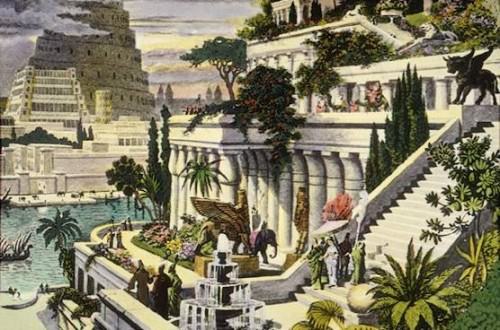
Hanging Gardens of Babylon
Archaeological evidence, as well as other ancient descriptions, clearly indicates that Babylon was not as large as Herodotus describes and had nowhere near 100 gates (it had only eight). It has thus been determined that this account was based on hearsay, rather than a personal visit, even though Herodotus writes as though he visited the site himself. As he had a great appreciation for the works of Homer (he bases the arrangement of his Histories on Homer's form) his passage on Babylon is thought to be emulating the earlier writer's description of Egyptian Thebes.
His penchant for storytelling, and his obvious talent for it, have alarmed and annoyed critics since antiquity but this very quality in the Histories is also what has made the work so greatly admired. Herodotus is able to bring a reader into the events of the stories he relates by creating vivid scenes with interesting characters and, sometimes, even dialogue.
He was hardly an impartial observer of the world he wrote about and often gives personal opinions at length on various people, customs, and events. While his admiration for Homer is always evident, he freely questioned the historical truth of The Iliad, asking why the Achaeans would wage so lengthy and costly a campaign as the Trojan War on behalf of one woman. This is only one of many examples of Herodotus' personality displaying itself in his work. Waterfield comments:
Certain kinds of narrative recur strikingly enough [in the Histories ] to make us feel we are seeing the idiosyncratic taste of the narrator emerging - that he enjoys a particular kind of story and, given the option, includes it when possible. Herodotus is fascinated by the interplay of nature and culture; the Scythians, living in a treeless land, invent a way of cooking meat in which the animal's bones and fat provide the fire and the stomach provides the pot in which the meat is cooked (4.61). He also singles out clever individuals and great achievements; he enjoys noting the `first inventor' of something, or a particularly striking building, or boat, or custom, or other cultural achievement. (xxxviii)
Herodotus personality, in fact, comes through quite often in the pages of his works. A reader understands that one is hearing from an individual with certain tastes and interests and that the author considers that what he has to say is important enough to require no explanation, qualification, or apology for perceived inaccuracy; if Herodotus felt like including something, he would include it and he never seems to care if readers find fault with that practice.
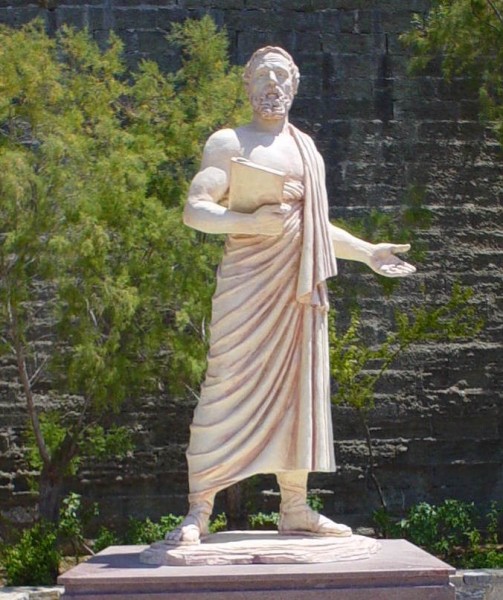
Herodotus of Halicarnassos
HERODOTUS IN THE HISTORIES
That he held himself in quite high regard is apparent in the prologue to the Histories which begins,
These are the researches of Herodotus of Halicarnassus, which he publishes, in the hope of thereby preserving from decay the remembrance of what men have done, and of preventing the great and wonderful actions of the Greeks and the Barbarians from losing their due meed of glory; and withal to put on record what were their grounds of feuds (I.1).
HERODOTUS ONCE REFUSED TO READ HIS BOOK TO A CROWD UNTIL THERE WAS AMPLE CLOUD COVER TO SHADE HIM ON THE PLATFORM.
Unlike other ancient writers (such as Homer, earlier, or Virgil, later), Herodotus does not attribute his narrative to divine sources, nor call on such for assistance, but announces clearly that this is his work and no others. His high opinion of himself is also displayed in what is recorded as the first `publication' of the Histories at the Olympic Games.
Works at this time were `published' by being read aloud and the Greek writer Lucian of Samosata (125-180 CE) claims that Herodotus read the entirety of his work to the audience in one sitting and received great applause. Another version of the publication of the work, however, claims that Herodotus refused to read his book to the crowd until there was ample cloud cover to shade him on the platform. While he waited, the audience left, and this event is what gave rise to the maxim, “Like Herodotus and his shade” alluding to one who misses an opportunity by waiting for optimal circumstances. Whichever account is true, if either is, they both reflect the esteem Herodotus was known to hold himself in.
LATER LIFE & DEATH
After travelling the world of his time, Herodotus came to live in the Greek Colony of Thurii, in Italy, where he edited and revised the Histories later in life. He had also lived in Athens and, at some point, it is thought he returned there. Scholars consider it likely that he died in Athens of the same plague that killed Athenian statesman Pericles (l. 495-429 BCE) sometime between 425 and 413 BCE.
His fame was so great that many different cities (Athens and Thurii among them) claimed to be the site of his funeral and grave and monuments were erected in his honor. The lasting significance of his work continues to be appreciated by millions of people today and he is considered a primary source for reliable information on the ancient world he observed and wrote about.
Bardr mac Imair › Who Was
Definition and Origins
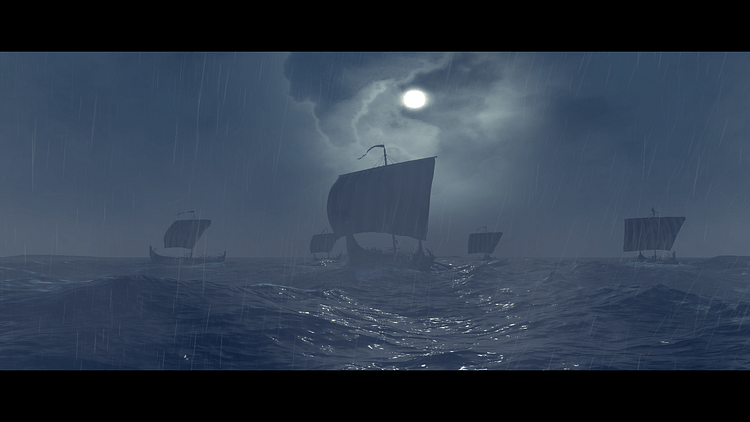
Bardr mac Imair (c. 873-881 CE, also known as Barid mac Imair, Barith, Baraid) was a Viking king of Dublin, son of the Viking king Imair (Imar, Ivan) who founded the Ui Imair Dynasty in Ireland. Bardr became king in Dublin after Imair's death. He engaged in military campaigns against the Irish monasteries and other religious institutions and is best known for his raids on various communities for plunder which was brought back to Dublin. He is known as a Viking sea-king based on his 873 CE raid on the Kingdom of Munster.
He died in 881 CE after one such raid on the oratory of St. Cianan or St. Ciaran, depending on different sources, in Dunleek, Meath. His death was attributed to an act of God and the saint in punishing Bardr for desecrating sacred sites for plunder.Bardr was succeeded by an unnamed king and then by his brother Sichfrith mac Imair (c. 883-888 CE) who continued his basic policies.
Little is known of Bardr's life because his biographers were the monks and clerics of Ireland who only took note of him in reference to his raids on their churches and monasteries. The little information available on him depicts him consistently as “a great Viking Tyrant,” but this is to be expected when one's life story is written by one's enemies. Even so, there are other Norse leaders mentioned in the Irish chronicles who are not so consistently depicted as brutal marauders and so it may well be that Bardr was as ruthless as the clerics claim.
SPONSORSHIP MESSAGE
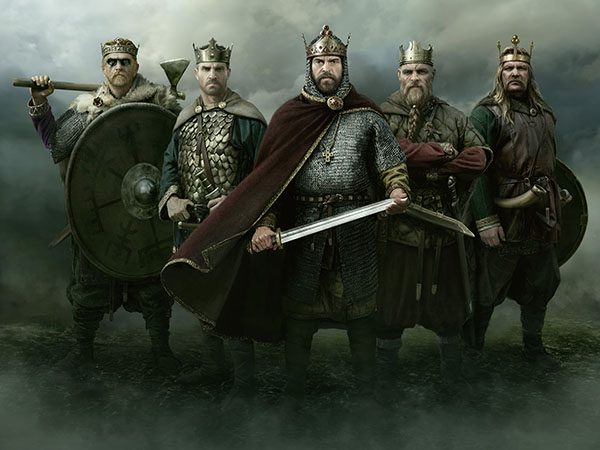
THE VIKINGS IN IRELAND
The various chronicles of the Irish during the Viking Age are never very flattering to the invaders and with good reason: the Vikings disrupted life in Ireland beginning in 795 CE with the sacking and burning of the monastic island of Rechru (Rathlin) followed shortly after by the destruction of St. Patrick's Island, one of the most revered monastic sites, in 798 CE. Viking raids would continue almost annually until 842 CE. It should be noted, however, that this date is only accepted as concluding the Viking raids because it corresponds to the rise of the Viking Kingdom of Dublin and a decrease in raids on Ireland from overseas; it does not signify an end to Viking raids or hostilities between the Vikings and the Irish.
The Vikings had first struck Britain in 793 CE in a bloody raid on the abbey of Lindisfarne and they would continue their attacks there while simultaneously raiding Irish sites. Their choice of monasteries most likely had little to do with religious differences and everything to do with easy access to rich plunder and food supplies. The monasteries and abbeys were often located along the coast and lent themselves to strikes from the sea.
The early raids were quick forays into Britain and Ireland in which the Vikings, in one or two ships, would strike quickly and depart with their stolen goods. By 807 CE, however, they were engaging in highly concerted efforts involving more ships and larger contingents. Between 811-822 CE, they had sacked and burned monasteries from Inismurray, off the coast of Sligo in the north, to Cork in the far south.
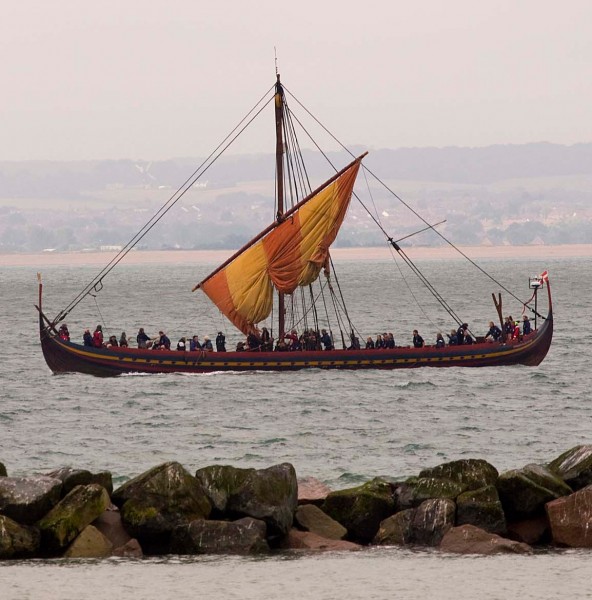
Viking Longship Replica
Their goals had advanced from portable plunder and food to captives they could sell into slavery or ransom back to their families. This same paradigm was held to with religious relics taken from churches and monasteries which, earlier, seem to have been stolen for the precious metal they were made from and jewels which adorned them but now were taken to be ransomed back.
The raids continued in attacks on Derry (833 CE) and Glendalough (834 and 836 CE) which prompted the monks to construct the now famous Round Towers. These structures were built with the doorway one floor up accessible by a ladder. When a Viking raid seemed imminent, the monks could flee to the Round Tower with the sacred books and relics and pull the ladder up. Each floor of the tower was also accessible only by ladder and each of these could be hauled up to the next floor if the one beneath were compromised.
The Viking raiders had already made a significant impact on the lives of the Irish but they had not yet made inroads into the country at large. Scholar Donnchadh O'Corrain notes how “no Viking is named in the Irish records before 837 and no king before the mid-ninth century. They kept to the edge; hardly ever much more than 30 kilometres from navigable water” (Sawyer, 87). This was the paradigm the Irish had become used to, but it was about to change.
THE LONGPHORTS WERE BUILT TO PROTECT THE VIKING SHIPS BUT ALSO FOR DEFENSE AGAINST LAND ATTACKS.
The Annals of Ulster record 840/841 CE as the first year the Vikings overwintered in Ireland and the appearance of the first Viking longphort (naval base). The longphorts were built to protect the Viking ships but also for defense against land attacks.The entry in the Annals from 841 CE reports a longphort at Dublin and then, in 842 CE, the entry reads, “The heathens are still at Duiblinn” (842.2). Now the Vikings could raid at will, not only during certain seasons, and launched raids against the lands of the Irish Ui Neill dynasty at will.
The Ui Neill were attempting to consolidate their power in the north and south of Ireland through the rule of a High King of Tara, chosen alternately from the northern and southern branches of the clan, and they fought back effectively. In 848 CE the Southern Ui Neill High King Mael Sechnaill I (rc 846-862 CE, father of the later High King Flann Sinna ) defeated the Viking forces in battle at Dublin, killing 700 of them, and destroying the longphort settlement.
The Viking forces at this time were not organized under a single leadership but seem to have followed the commands of a local leader. In 849 CE a fleet of ships from Denmark arrived in Ireland to impose order on the Norse raiders there. The struggle between the Danes and the Norse of Ireland “disturbed the whole country,” according to the Annals of Ulster, until the Danes were driven off sometime in c. 852 CE. After the Danes had left, however, the Norse were given no time to resume their former raids as a new figure arrived who would change the Irish landscape permanently.
THE COMING OF AMLAIB CONUNG
While the Norse had been conducting their raids in Ireland, other Viking armies had been at work elsewhere in Britain and Scotland and other regions. In 853 CE a Viking prince named Amlaib Conung (r. 853-871 CE) arrived in Ireland. His name means Amlaib the King, and he is sometimes referred to as Olaf and associated with the Viking sea-king Olaf the White (though this claim is challenged).
Who he was and whatever he did prior to this time is unknown but he was clearly a powerful figure. The Norse instantly submitted to his rule, and the Irish were compelled to give him tribute. Amlaib is called “son of the king of Laithlind” in the annals and this is thought to correspond to Nordic Scotland and not, as previously thought, to Norway.

The Vikings in Dublin, 841 CE
Amlaib organized the Norse in Dublin as their first king and then left for military campaigns in Britain. When he returned in 857 CE, it was in the company of two other princes (or at least nobles) named Auisle and Imair who are called his “brothers” in the annals; whether this means they were brothers by blood or brothers-in-arms is unclear.
THE KINGS OF DUBLIN
Amlaib, Auisle (r. 863-867CE), and Imair (r. 863-873 CE) ruled Dublin as co-kings beginning in 863 CE but even before Auisle and Imair were elevated by Amlaib to kingship they took part in and coordinated the military campaigns of the Norse in Ireland far more effectively than had been done in the past. There were now well-planned military expeditions instead of hit-and-run raids, and the spoils of these battles went to the treasury of Dublin instead of being divided among a local war -chief and his band.
The difference in before and after Amlaib is apparent in the raids on settlements in Brega by the Norse of Dublin in 856 CE – when Amlaib was still in Britain – which followed the traditional style established, and the concerted military campaign led to victory by Amlaib and Imair against the Norse-Gaels of Munster in 857 CE.
In 859 CE Amlaib and Imair joined forces with Cerball mac Dunlainge, King of Ossory (842-888 CE), a small kingdom near Munster, in an attack on the High King Mael Sechnaill. They were defeated, and Cerball later sued for peace and submitted to Mael Sechnaill, but the kings of Dublin continued to make and break alliances as they fought with and against various Irish kings.
In c. 862 CE, Aed Findliath (r. 862-879 CE) succeeded Mael Sechnaill as High King of Tara and allied himself with Amlaib, Auisle, and Imair as he launched attacks on the Kingdom of Mide (Meath). By 866 CE Aed Findliath was their enemy and destroyed the longphorts of Amlaib all down the northern coast.
The Norse retaliated in 867 CE with a campaign against the Irish, and the Irish responded by burning Amlaib's fortress at Clondalkin. Amlaib and Imair then sacked and burned the monastery of Armagh, sacred to the memory of St. Patrick, and carried off almost 1,000 citizens to be sold as slaves. This act was considered a great sacrilege, but Amlaib had been guilty of an even greater one earlier.
In 863 CE Amlaib, Auisle, and Imair had led an expeditionary force into the Boyne Valley where they raided the megalithictombs (such as Newgrange and Knowth) and carried off anything of value. The valley was not only the site of the ancient Neolithic tombs but also of those of the high kings of Ireland. The annals only record the sacrilege of the heathens in desecrating the tombs and name only the leaders, but it is possible, even likely, that the sons of these leaders – including Bardr – took part in the campaign. Either before or after their sack of the tombs, Amlaib's forces also defeated the kings of Brega and Leinster.

Neolithic Mounds at Knowth
In 867 CE Amlaib and Imair killed Auisle in a dispute over Amlaib's wife. The Fragmentary Annals of Ireland state that the two brothers had already decided to kill the third when Auisle admitted an affair with Amlaib's wife; Amlaib then killed him, slaughtered his followers, and took all his goods (347). Amlaib continued to war with Aed Findliath and others while also conducting campaigns in Scotland. He vanishes from the historical record in 871 CE and is presumed to have died in battle there.
Imair then founded the Ui Imair dynasty which would control the sea routes, western Scotland, and parts of Britain through the 12th century CE. Imair has often been associated with the famous Viking leader Ivar the Boneless (d. 870 CE) who was part of the leadership of the Great Army of 865 CE which campaigned in Britain. Led by Halfdan Ragnarsson (also known as Halfdane, c. 865-877 CE) and Ivar, this army was the best organized and most effective Viking force to invade Britain up to that date.
It is possible that Ivar and Imair are the same man, but no scholarly consensus has been reached. The probability is great, however, that the leader who so effectively organized the Norse in Ireland is the same as the one who did so in Britain;especially so when one considers that Ivar and Imair are versions of the same name.
Imair is said to have died in 873 CE as King of the Norsemen of All Ireland and Britain. After his death, power passed to his son Bardr, who most likely had been accompanying him on campaigns for some time.
BARDR'S REIGN
As noted, Bardr most likely took part in the campaign of the Boyne Valley in 863 CE but he is first recorded by name in 867 CE where he is called a Jarl of Laithlind (an earl) who was attacked, along with another Jarl named Haimar, in an ambush by the men of Connacht. Haimar was killed, but Bardr escaped and later would return. In 872 CE the Fragmentary Annals record a raid he led on the islands of Lough Ree and the Kingdom of Magh Luirg (Moylurg), both in Connacht. No mention is made of plunder, but many citizens seem to have been taken for sale as slaves.
Dublin had become a major center of the slave trade under the reign of Amlaib and his brothers. Sales of slaves, in fact, generated more wealth for the growing city than any other commodity. Amlaib's attack on Armagh in 869 CE was most likely as much for the 1,000 people he could sell as slaves as any retaliation against the Irish. Bardr's activity in Connacht focused on capturing citizens for the slave trade, and although it is not documented, this was most likely the reason the men of Connacht tried to kill him. It is also likely that Bardr had been active in the region long before his raids on the islands of Lough Ree and Magh Luirg.

Viking Attack
In 873 CE, according to the Annals of Inisfallen, “Barid [Bardr] with a great fleet from Ath Cliath [Dublin] went by sea westwards and he plundered Ciarraige Luachra under ground, ie the raiding of the caves” (873). This raid was conducted with Bardr's cousin Oistin mac Amlaib, Amlaib's son, who is sometimes cited as a co-ruler with Bardr, though this is contested.Bardr is credited with being a Viking sea-king, and it is possible that his reputation comes from this raid. It is probable he took his fleet down the east coast of Ireland to strike at modern-day County Kerry on the south-west coast. County Kerry is associated with the designation of Ciarraige Luachra which designated a people of the Kingdom of Munster.
Alternately, it is possible he took his fleet down the rivers which the Vikings had been navigating by that time for almost eighty years. The exact location of where he raided “under ground” has not been agreed on by scholars, and possibly it was another location in the modern-day Munster province. It is agreed, however, that the “raiding of the caves” refers to plundering tombs for treasure. In this, Bardr seems to have reverted to the old methods of conducting military campaigns which prevailed before the coming of Amlaib.
This possibility gains more weight with the next entry for Bardr in the annals, which describes the sack of Armagh in 879 CE by “heathen” forces from Dublin. Bardr's name is not mentioned, but as King of Dublin in 879 CE, he would have either led the expedition or commissioned it. In this 879 CE raid, the abbot and lector of Armagh were captured and held for ransom.
The last entry on Bardr's reign – and life – is the entry in the annals from 881 CE, which describes his raid on the oratory of the saint Cianan or St. Ciaran and his death – either by drowning or burning – shortly afterwards. The oratory of St. Cianan in Duleek (County Meath) is the most probable site, and the entry claims it was destroyed “by foreigners” and that afterwards Bardr, “a great despot of the Northmen, was killed by St. Cianan” (Annals of Ulster, 881). The Annals of Ulster claim that he drowned at Dublin following the raid while the Annals of the Kingdom of Ireland (also known as the Annals of the Four Masters) and Chronicon Scotorum state that he was “killed and burnt” after the raid. All of the sources attribute his death to a miracle enacted by the saint whose oratory was desecrated.
CONCLUSION
Although the sources on Bardr's reign are obviously biased and must be interpreted with care, there is every reason to believe they are accurate when it comes to this particular king. The actions ascribed to Bardr fit with a paradigm of the earlier raids on Irish churches and monasteries and involve some of the same sites as military campaigns by his uncles and father.
Bardr the sea-king of Dublin most likely gained his reputation from his 873 CE raid and then enhanced upon it through traditional hit-and-run raids which would have supplied him not only with ready cash and food supplies but an abundance of citizens who could be sold as slaves. The ability of Bardr's brother and successor Sichfrith to wage his campaigns after Bardr's death attests to considerable resources which most likely came from Bardr's financial successes in the slave trade of medieval Viking Dublin.
Ancient Greek Warfare › Origins&
Definition and Origins

In the ancient Greek world, warfare was seen as a necessary evil of the human condition. Whether it be small frontier skirmishes between neighbouring city -states, lengthy city-sieges, civil wars, or large-scale battles between multi-alliance blocks on land and sea, the vast rewards of war could outweigh the costs in material and lives. Whilst there were long periods of peace and many examples of friendly alliances, the powerful motives of territorial expansion, war booty, revenge, honour, and the defence of liberty ensured that throughout the Archaic and Classical periods the Greeks were regularly engaged in warfare both at home and abroad.
CITY-STATE RIVALRIES
Evolving from armed bands led by a warrior leader, city militia of part-time soldiers, providing their own equipment and perhaps including all the citizens of the city-state or polis, began to move warfare away from the control of private individuals and into the realm of the state. Assemblies or groups of elite citizens sanctioned war, and generals ( strategoi ) came to be accountable for their actions and were often elected for fixed terms or specific military operations.
In the early stages of Greek Warfare in the Archaic period, training was haphazard and even weapons could be makeshift, although soldiers were usually paid, if only so that they could meet their daily needs. There were no uniforms or insignia and as soon as the conflict was over the soldiers would return to their farms. By the 5th century BCE the military prowess of Spartaprovided a model for all other states to follow. With their professional and well-trained full-time army dressed in red cloaks and carrying shields emblazoned with the letter lambda (for Lacedaemonians), the Spartans showed what professionalism in warfare could achieve.
WARFARE MOVED AWAY FROM ONE-OFF BATTLES FOUGHT IN A FEW HOURS TO LONG-DRAWN-OUT CONFLICTS WHICH COULD LAST FOR YEARS.
Many states such as Athens, Argos, Thebes, and Syracuse began to maintain a small professional force ( logades or epilektoi ) which could be augmented by the main citizen body if necessary. Armies became more cosmopolitan with the inclusion of resident foreigners, slaves, mercenaries, and neighbouring allies (either voluntary or through compulsion in the case of Sparta's perioikoi ). Warfare moved away from one-off battles fought in a few hours to long-drawn-out conflicts which could last for years, the most important being the Persian Wars (first half of the 5th century BCE), the Peloponnesian Wars (459-446 & 431-404 BCE), and the Corinthian Wars (394-386 BCE).
THE HOPLITE PHALANX
The mainstay of any Greek army was the hoplite. His full panoply was a long spear, short sword, and circular bronze shield and he was further protected, if he could afford it, by a bronze helmet (with inner padding for comfort), bronze breastplate, greaves for the legs and finally, ankle guards. Fighting was at close-quarters, bloody, and lethal. This type of warfare was the perfect opportunity for the Greek warrior to display his manliness ( andreia ) and excellence ( aretē ) and generals led from the front and by example.

Greek Hoplites
To provide greater mobility in battle the hoplite came to wear lighter armour such as a leather or laminated linen corselet ( spolades ) and open-faced helmet ( pilos ). The peltast warrior, armed with short javelins and more lightly-armoured than the hoplite became a mobile and dangerous threat to the slower moving hoplites. Other lighter-armed troops ( psiloi ) also came to challenge the hoplite dominance of the battlefield. Javelin throwers ( akonistai ), archers ( toxotoi ) and slingers ( sphendonētai) using stones and lead bullets could harry the enemy with attacks and retreats. Cavalry ( hippeis ) was also deployed but due to the high costs and difficult terrain of Greece, only in limited numbers eg, Athens, possessing the largest cavalry force during the Peloponnesian Wars had only 1,000 mounted troops. Decisive and devastating cavalry offensives would have to wait until the Macedonians led by Philip and Alexander in the mid-4th century BCE.
THE PHALANX WAS A LINE OF WELL-ARMED & WELL-ARMOURED HOPLITE SOLDIERS USUALLY 8-12 MEN DEEP WHICH ATTACKED AS A TIGHT GROUP.
Armies also became more structured, split into separate units with hierarchies of command. The lochoi was the basic unit of the phalanx - a line of well-armed and well-armoured hoplite soldiers usually eight to twelve men deep which attacked as a tight group. In Athens the lochos was led by a captain ( lochagos ) and these combined to form one of ten regiments ( taxeis ) each led by a taxiarchos. A similar organisation applied to the armies of Corinth, Argos, and Megara. In 5th century Sparta the basic element was the enomotiai (platoon) of 32 men. Four of these made up a pentekostys (company) of 128 men. Four of these made up a lochos (regiment) of 512 men. A Spartan army usually consisted of five lochoi with separate units of non-citizen militia -- perioikoi. Units might also be divided by age or speciality in weaponry and, as warfare became more strategic, these units would operate more independently, responding to trumpet calls or other such signals mid-battle.
WAR AT SEA: THE TRIREME
Some states such as Athens, Aegina, Corinth, and Rhodes amassed fleets of warships, most commonly the trireme, which could allow these states to forge lucrative trading partnerships and deposit troops on foreign territory and so establish and protect colonies. They could even block enemy harbours and launch amphibious landings. The biggest fleet was at Athens, which could amass up to 200 triremes at its peak, and which allowed the city to build and maintain a Mediterranean-wide empire.

Greek Trireme
The trireme was a light wooden ship, highly manoeuvrable and fitted with a bronze battering ram at the bow which could disable enemy vessels. Thirty-five metres long and with a 5 metre beam, some 170 rowers ( thetes - drawn from the poorer classes) sitting on three levels could propel the ship up to a speed of 9 knots. Also on board were small contingents of hoplites and archers, but the principal tactic in naval warfare was ramming not boarding. Able commanders arranged their fleets in a long front so that it was difficult for the enemy to pass behind ( periplous ) and ensure his ships were sufficiently close to prevent the enemy going through a gap ( diekplous ). Perhaps the most famous naval battle was Salamis in 480 BCE when the Athenians were victorious against the invading fleet of Xerxes.
However, the trireme had disadvantages in that there was no room for sleeping quarters and so ships had to be dry-docked each night, which also prevented the wood becoming water-logged. They were also fantastically expensive to produce and maintain; indeed the trireme was indicative that now warfare had become an expensive concern of the state, even if rich private citizens were made to fund most of the expense.
BATTLE STRATEGIES
The first strategy was actually employed before any fighting took place at all. Religion and ritual were important features of Greek life, and before embarking on a campaign, the will of the gods had to be determined. This was done through the consultation of oracles such as that of Apollo at Delphi and through animal sacrifices ( sphagia ) where a professional diviner ( manteis ) read omens ( ta hiera ), especially from the liver of the victim and any unfavourable signs could certainly delay the battle. Also, at least for some states like Sparta, fighting could be prohibited on certain occasions such as religious festivals and for all states during the great Panhellenic games (especially those at Olympia ).
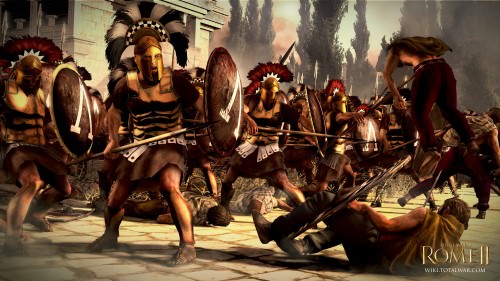
Spartan Warriors
When all of these rituals were out of the way, fighting could commence but even then it was routine to patiently wait for the enemy to assemble on a suitable plain nearby. Songs were sung (the paian - a hymn to Apollo) and both sides would advance to meet each other. However, this gentlemanly approach in time gave way to more subtle battle arrangements where surprise and strategy came to the fore. What is more, conflicts also became more diverse in the Classical period with sieges and ambushes, and urban fighting becoming more common, for example at Solygeia in 425 BCE when Athenian and Corinthian hoplites fought house to house.
Strategies and deception, the 'thieves of war' ( klemmata ), as the Greeks called them, were employed by the more able and daring commanders. The most successful strategy on the ancient battlefield was using hoplites in a tight formation called the phalanx. Each man protected both himself and partially his neighbour with his large circular shield, carried on his left arm.Moving in unison the phalanx could push and attack the enemy whilst minimising each man's exposure. Usually eight to twelve men deep and providing the maximum front possible to minimise the risk of being outflanked, the phalanx became a regular feature of the better-trained armies, particularly the Spartans. Thermopylae in 480 BCE and Plataea in 479 BCE were battles where the hoplite phalanx proved devastatingly effective.
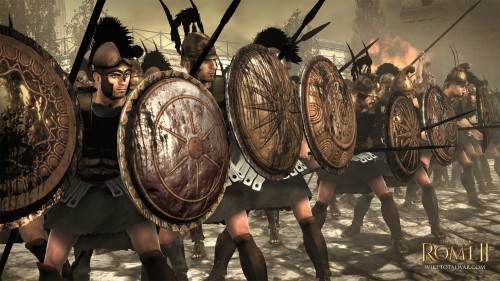
Greek Phalanx
At the Battle of Leuktra in 371 BCE Theban general Epaminondas greatly strengthened the left flank of his phalanx to about 50 men deep which meant he could smash the right flank of the opposing Spartan phalanx, a tactic he used again with great success at Mantineia in 362 BCE. Epaminondas also mixed lighter armed troops and cavalry to work at the flanks of his phalanx and harry the enemy. Hoplites responded to these developments in tactics with new formations such as the defensive square ( plaision ), used to great effect (and not only in defence) by Spartan general Brasidas in 423 BCE against the Lyncestians and again by the Athenians in Sicily in 413 BCE. However, the era of heavily armoured hoplites neatly arranged in two files and slashing away at each other in a fixed battle was over. More mobile and multi-weapon warfare now became the norm. Cavalry and soldiers who could throw missiles might not win battles outright but they could dramatically affect the outcome of a battle and without them the hoplites could become hopelessly exposed.
SIEGES WERE USUALLY LONG-DRAWN-OUT AFFAIRS WITH THE PRINCIPAL STRATEGY BEING TO STARVE THE ENEMY INTO SUBMISSION.
SIEGE WARFARE
From an early stage, most Greek city-states had a fortified acropolis (Sparta and Elis being notable exceptions) to protect the most important religious and civic buildings and provide refuge from attack. However, as warfare became more mobile and moved away from the traditional hoplite battle, cities sought to protect their suburbs with fortification walls. Independent lookout towers in the surrounding countryside and even frontier forts and walls sprang up in response to the increased risk of attacks. Many poleis also built fortifications to create a protective corridor between the city and their harbour, the most famous being the Long Walls which spanned the 7 km between Athens and Piraeus.
Sieges were usually long-drawn-out affairs with the principal strategy being to starve the enemy into submission. Offensive strategies using battering rams and ramps proved largely unsuccessful. However, from the 4th century BCE technical innovations gave the attackers more advantages. Wheeled siege towers, first used by the Carthaginians and copied by Dionysius I of Syracuse against Motya in 397 BCE, bolt-throwing artillery ( gastraphetes ), stone throwing apparatus ( lithoboloi) and even flame-throwers (at Delion in 424 BCE) began a trend for commanders to be more aggressive in siege warfare.However, it was only with the arrival of torsion artillery from 340 BCE, which could propel 15 kg stones over 300 metres, that city walls could now be broken down. Naturally, defenders responded to these new weapons with thicker and stronger walls with convex surfaces to better deflect missiles.
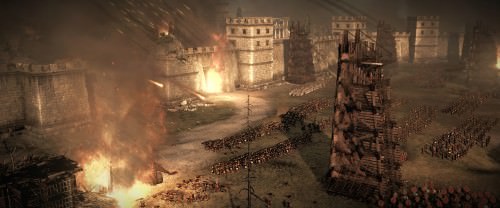
Siege Warfare
LOGISTICS: BAGGAGE & SUPPLIES
The short duration of conflicts in the Greek world was often because of the poor logistics supplying and maintaining the army in the field. Soldiers were usually expected to provide their own rations (dried fish and barley porridge being most common) and the standard for Athens was three-days' worth. Most hoplites would have been accompanied by a slave acting as a baggage porter ( skeuophoroi ) carrying the rations in a basket ( gylion ) along with bedding and a cooking pot. Slaves also acted as attendants to the wounded as only the Spartan army had a dedicated medical officer ( iatroi ). Fighting was usually in the summer so tents were rarely needed and even food could be pillaged if the fighting was in enemy territory. Towards the end of the Classical period armies could be re-supplied by ship and larger equipment could be transported using wagons and mules which came under the responsibility of men too old to fight.
SPOILS OF VICTORY
War booty, although not always the primary motive for conflict, was certainly a much-needed benefit for the victor which allowed him to pay his troops and justify the expense of the military campaign. Booty could come in the form of territory, money, precious materials, weapons, and armour. The losers, if not executed, could expect to be sold into slavery, the normal fate for the women and children of the losing side. It was typical for 10% of the booty (a dekaten ) to be dedicated in thanks to the gods at one of the great religious sanctuaries such as Delphi or Olympia. These sites became veritable treasuries and, effectively, museums of weapons and armour. They also became too tempting a target for more unscrupulous leaders in later times, but still the majority of surviving military material comes from archaeological excavations at these sites.
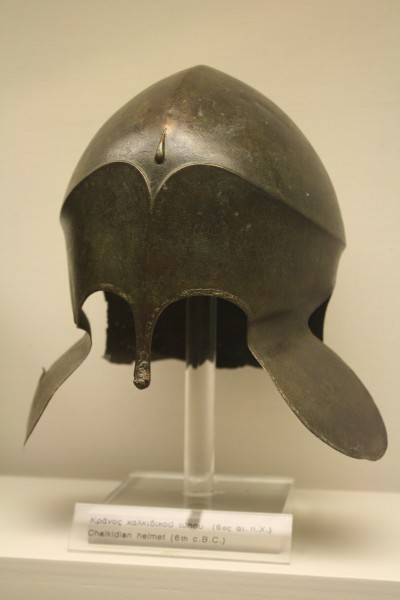
Chalcidian Helmet
Important rituals had to be performed following victory which included the recovering of the dead and the setting up of a victory trophy (from tropaion, meaning turning point in the conflict) at the exact place on the battlefield where victory became assured.The trophy could be in the form of captured weapons and armour or an image of Zeus ; on occasion memorials to the fallen were also set up. Speeches, festivals, sacrifices and even games could also be held following a victory in the field.
CONCLUSION
Greek warfare, then, evolved from small bands of local communities fighting for local territory into massive set-piece battles between multi-allied counterparts. War became more professional, more innovative, and more deadly, reaching its zenith with the Macedonian leaders Philip and Alexander. Learning from the earlier Greek strategies and weapons innovations, they employed better hand weapons such as the long sarissa spear, used better artillery, successfully marshalled diverse troop units with different arms, fully exploited cavalry, and backed all this up with far superior logistics to dominate the battlefield not only in Greece but across vast swathes of Asia and set the pattern for warfare through Hellenistic and into Roman times.
LICENSE:
Article based on information obtained from these sources:with permission from the Website Ancient History Encyclopedia
Content is available under License Creative Commons: Attribution-NonCommercial-ShareAlike 3.0 Unported. CC-BY-NC-SA License
